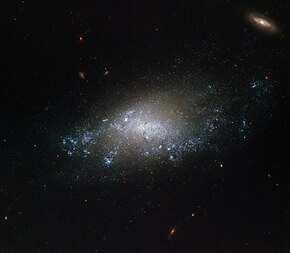
NGC 5755 is a barred spiral galaxy in the constellation Boötes, member of Arp 297 interacting galaxies group of four: NGC 5752, NGC 5753, NGC 5754, and NGC 5755.
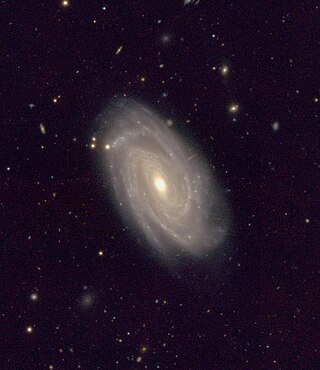
NGC 10 is a spiral galaxy located in the southern constellation of Sculptor. It was discovered by John Herschel on 25 September 1834. The galaxy is located at a distance of 346 Mly from the Sun. Its morphological classification in the De Vaucouleurs system is SAB(rs)bc, where the 'SAB' denotes a weak-barred spiral, '(rs)' indicates a slight ring-like structure, and 'bc' means the spiral arms are moderately to loosely wound. Paturel et al. (2003) assigned this galaxy a classification of SBbc, indicating a barred spiral galaxy.

NGC 12 is an intermediate spiral galaxy in the Pisces constellation. It was discovered by William Herschel on December 6, 1790.

NGC 24 is a spiral galaxy in the southern constellation of Sculptor, about 23.8 megalight-years distant from the Milky Way. It was discovered by British astronomer William Herschel in 1785, and measures some 40,000 light-years across. The general shape of this galaxy is specified by its morphological classification of SA(s)c, which indicates it is an unbarred spiral with no ring-like structure and moderate to loosely-wound spiral arms. This galaxy is positioned in the vicinity of the Sculptor Group, but is actually a background object that is more than three times as distant. It may form a pair with another background galaxy, NGC 45.
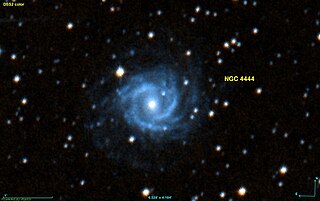
NGC 4444 is an intermediate spiral galaxy in the constellation Centaurus. The morphological classification places it midway on the continuum between a barred spiral (SB) and an unbarred spiral (SA), with an inner region that lies between a ring-like (r) and a purely spiral form (s), and medium- (b) to loosely wound (c) outer spiral arms. This makes it a hybrid ringed, barred spiral galaxy. It has an angular size of 2.4 × 1.6 arcminutes and the estimated mass M is given log M = 9.76, yielding 5.8 billion solar masses.

NGC 3185 is a spiral galaxy located 20.4 Mpc away in the Leo constellation. NGC 3185 is a member of a four-galaxy group called HCG 44. It is also a member of the NGC 3190 Group of galaxies, which is a member of the Leo II Groups, a series of galaxies and galaxy clusters strung out from the right edge of the Virgo Supercluster.

NGC 4217 is an edge-on spiral galaxy which lies approximately 60 million light-years away in the constellation of Canes Venatici. It is a possible companion galaxy to Messier 106.

NGC 3718, also called Arp 214, is a galaxy located approximately 52 million light years from Earth in the constellation Ursa Major. It is either a lenticular or spiral galaxy.

NGC 3059 is a barred spiral galaxy. It is located in the constellation of Carina. The galaxy can be described as being faint, large, and irregularly round. It was discovered on February 22, 1835, by John Herschel. The galaxy has been calculated to be 45 - 50 million lightyears from Earth.
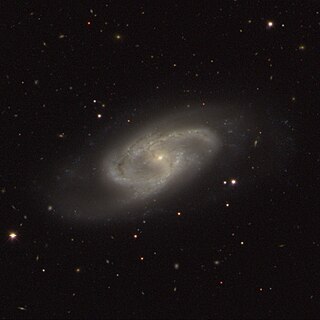
NGC 150 is a barred spiral galaxy in the constellation Sculptor. It is about 70 million light years away from the Solar System, and it has a diameter of about 55,000 light years. It was discovered on 20 November 1886, by Lewis A. Swift. The Type II supernova SN 1990K was detected in NGC 150, and was reported to be similar to SN 1987A.

NGC 164 is a spiral galaxy located in the constellation Pisces. It was found by the German astronomer Albert Marth on 3 August 1864.

NGC 5002 is a Magellanic spiral galaxy in Canes Venatici. It was discovered by Heinrich d'Arrest in 1865. It is also known as MCG 6-29-51, PGC 45728, UGC 8254.

NGC 479 is a spiral galaxy in the constellation Pisces. It was discovered by German astronomer Albert Marth on October 27, 1864. It is about 240 million light-years away from Earth.

NGC 880 is a spiral galaxy located in the constellation Cetus about 590 million light-years from the Milky Way. It was discovered by the American astronomer Francis Leavenworth in 1886.

NGC 950 is a barred spiral galaxy in the constellation Cetus. It is approximately 205 million light-years away from the Solar System and has a diameter of about 85,000 light-years. The object was discovered in 1886 by American astronomer and mathematician Ormond Stone.
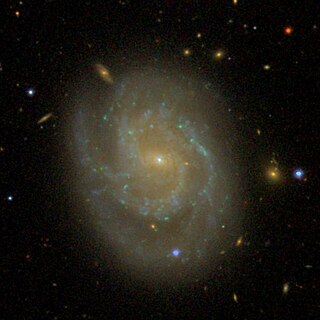
NGC 3686 is a spiral galaxy that forms with three other spiral galaxies, NGCs 3681, 3684, and 3691, a quartet of galaxies in the Leo constellation. It was discovered on 14 March 1784 by William Herschel. It is a member of the NGC 3607 Group of galaxies, which is a member of the Leo II Groups, a series of galaxies and galaxy clusters strung out from the right edge of the Virgo Supercluster.

NGC 937 is a barred spiral galaxy located in the constellation Andromeda about 251 million light years from the Milky Way. It was discovered by the French astronomer Édouard Stephan on 12 December 1884.

NGC 941 is an intermediate spiral galaxy in the constellation Cetus. It is an estimated 16.83 MPc from the Milky Way and has a diameter of approximately 55,000 light years. The galaxies NGC 926, NGC 934, NGC 936, NGC 955 are located in the same sky area. NGC 941 was discovered by the astronomer William Herschel on 6 January 1785.

NGC 5619 is an intermediate spiral galaxy in the constellation Virgo. The galaxy was found on April 10, 1828, by the British astronomer John Herschel. It is located about 390 million light-years away from the Sun.

NGC 624 is a barred spiral galaxy in the constellation of Cetus, which is about 264 million light years from the Milky Way. It was discovered on November 28, 1785, by the German-British astronomer William Herschel.
